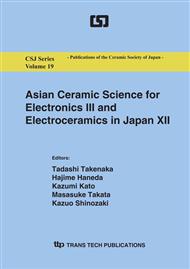p.131
p.135
p.139
p.143
p.148
p.153
p.157
p.161
p.165
Growth and Electrical Properties of PbMg0.047Nb0.095Zr0.416Ti0.442O3 Films Fabricated by Metalorganic Decomposition
Abstract:
On the basis of experimental data on the piezoelectric pinpoint composition of ceramics of the ternary system Pb(Mg1/3Nb2/3)O3-PbZrO3-PbTiO3 (PMNZT), which we investigated in our previous report, epitaxial PbMg0.047Nb0.095Zr0.416Ti0.442O3 thick films with thicknesses ranging from 0.4 to 1.9 m were fabricated on Pt(100)/MgO(100) substrates by metalorganic decomposition. The film- thickness dependence on the structural and electrical properties (dielectric, piezoelectric and ferroelectric properties) was investigated. All PMNZT films exhibited a highly uniform (001) orientation, regardless of the film thickness. The cross-sectional transmission electron microscope micrographs and all the physical data suggest that high-density PMNZT thick films with a thickness 1.0 m can be expected to function as highly electrically insulating capacitors with high potential for piezo- and ferroelectric applications.
Info:
Periodical:
Pages:
148-152
Citation:
Online since:
December 2009
Price:
Сopyright:
© 2010 Trans Tech Publications Ltd. All Rights Reserved
Share:
Citation:


